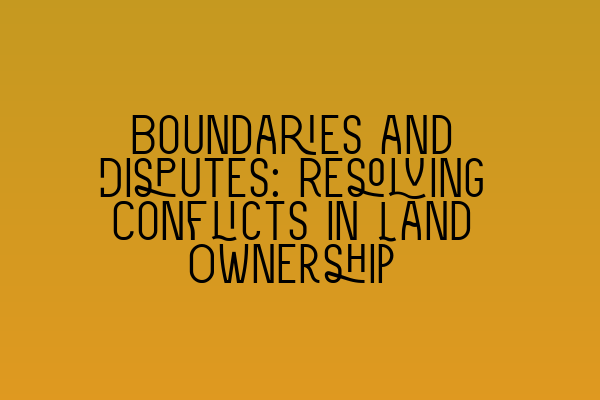Boundaries and Disputes: Resolving Conflicts in Land Ownership
Welcome to the SQE Property Law & Land Law blog, where we explore various aspects of property law and provide expert insights for our readers. In this edition, we will delve into a common issue that arises in land ownership – boundaries and disputes.
Land boundaries are often a source of contention between neighbors and can lead to legal disputes if not properly resolved. Disputes can arise over the exact location of a boundary line, encroachments, easements, or rights of way. As a solicitor specializing in property law, it is our duty to help clients navigate these matters and find amicable solutions.
The Importance of Accurate Boundary Identification
One of the primary reasons for boundary disputes is the lack of a clear and accurate identification of the boundary line. In some cases, boundaries may not be clearly defined in the original property deed or legal documentation, leading to confusion and disagreement between property owners.
Therefore, it is crucial to conduct a thorough investigation and analysis of the property’s legal description, historical maps, and surveys to determine the exact location of the boundary. This may involve engaging a professional surveyor who can provide precise measurements and establish the boundary line.
By accurately identifying the boundary, individuals can avoid unnecessary conflicts and ensure that their rights as landowners are protected.
Resolving Boundary Disputes
When a boundary dispute arises, it is important to approach the situation in a calm and objective manner. Engaging in open and respectful communication with the neighboring property owner can often help in finding a resolution.
However, if negotiations fail, it may be necessary to seek legal assistance. As solicitors specializing in property law, we are experienced in handling boundary disputes and can guide clients through the necessary legal procedures.
One common approach is to employ Alternative Dispute Resolution (ADR) methods such as mediation or arbitration. These processes aim to facilitate a fair and unbiased resolution through negotiation or a third-party decision-maker.
In cases where ADR is unsuccessful or not feasible, the dispute may need to be resolved through litigation. Litigation involves presenting the case in a court of law, where a judge will make a final determination based on the evidence presented.
Protecting Your Rights as a Landowner
As a landowner, it is essential to understand and safeguard your rights. Property deeds, surveys, and other legal documentation play a crucial role in establishing and protecting those rights. It is important to retain copies of these documents and consult with a solicitor to ensure they are accurate and up-to-date.
Additionally, it is worth considering title insurance, which can provide financial protection against potential boundary disputes and other property ownership issues.
Conclusion
Boundary disputes can be complex and emotionally charged, but with the right approach and legal guidance, a fair resolution can be achieved. At SQE Property Law & Land Law, we are dedicated to assisting our clients in resolving any land ownership conflicts they may face.
If you require legal assistance or have any questions related to property law, please do not hesitate to contact us. Our team of skilled solicitors is ready to provide professional advice and support.
Related Articles:
